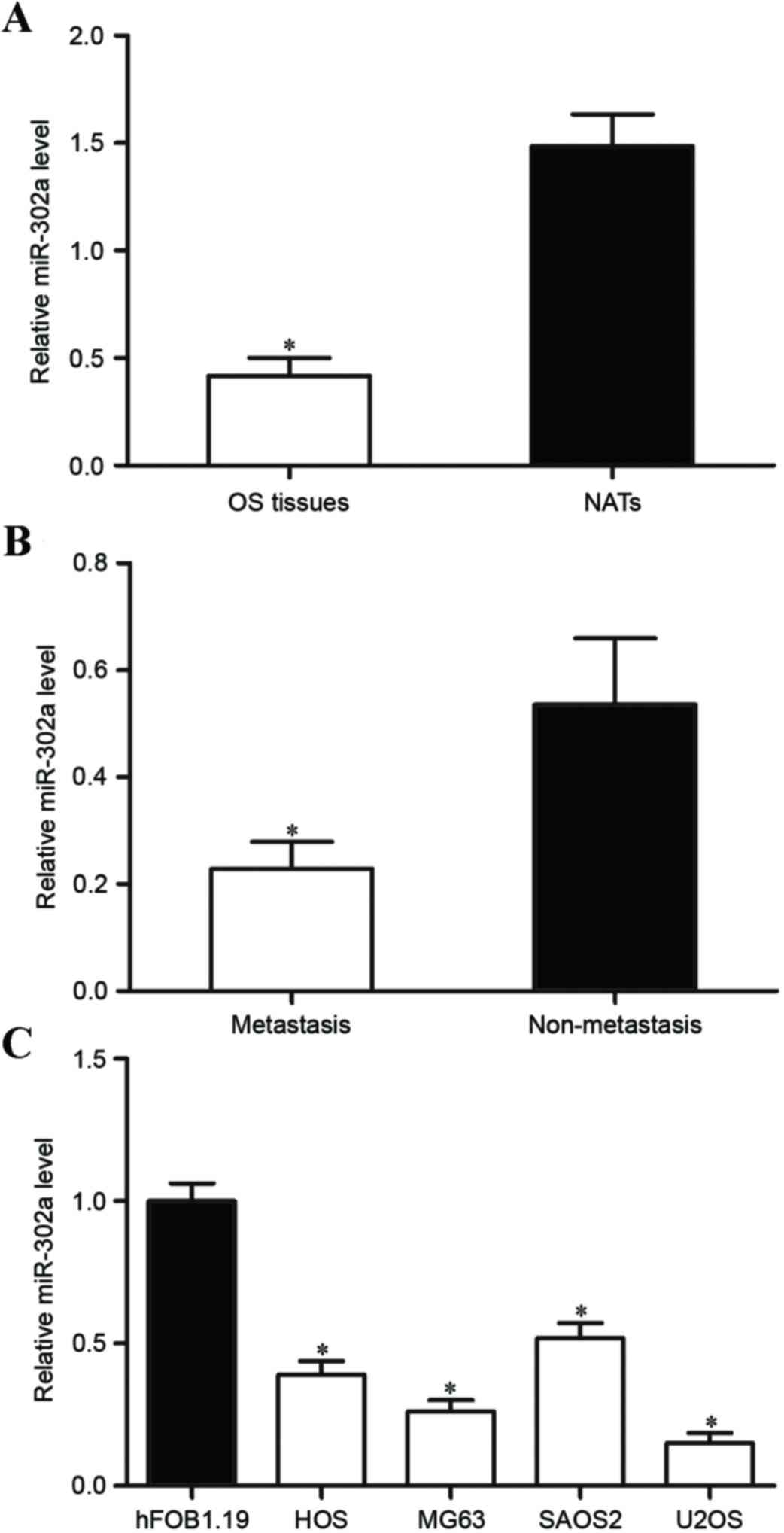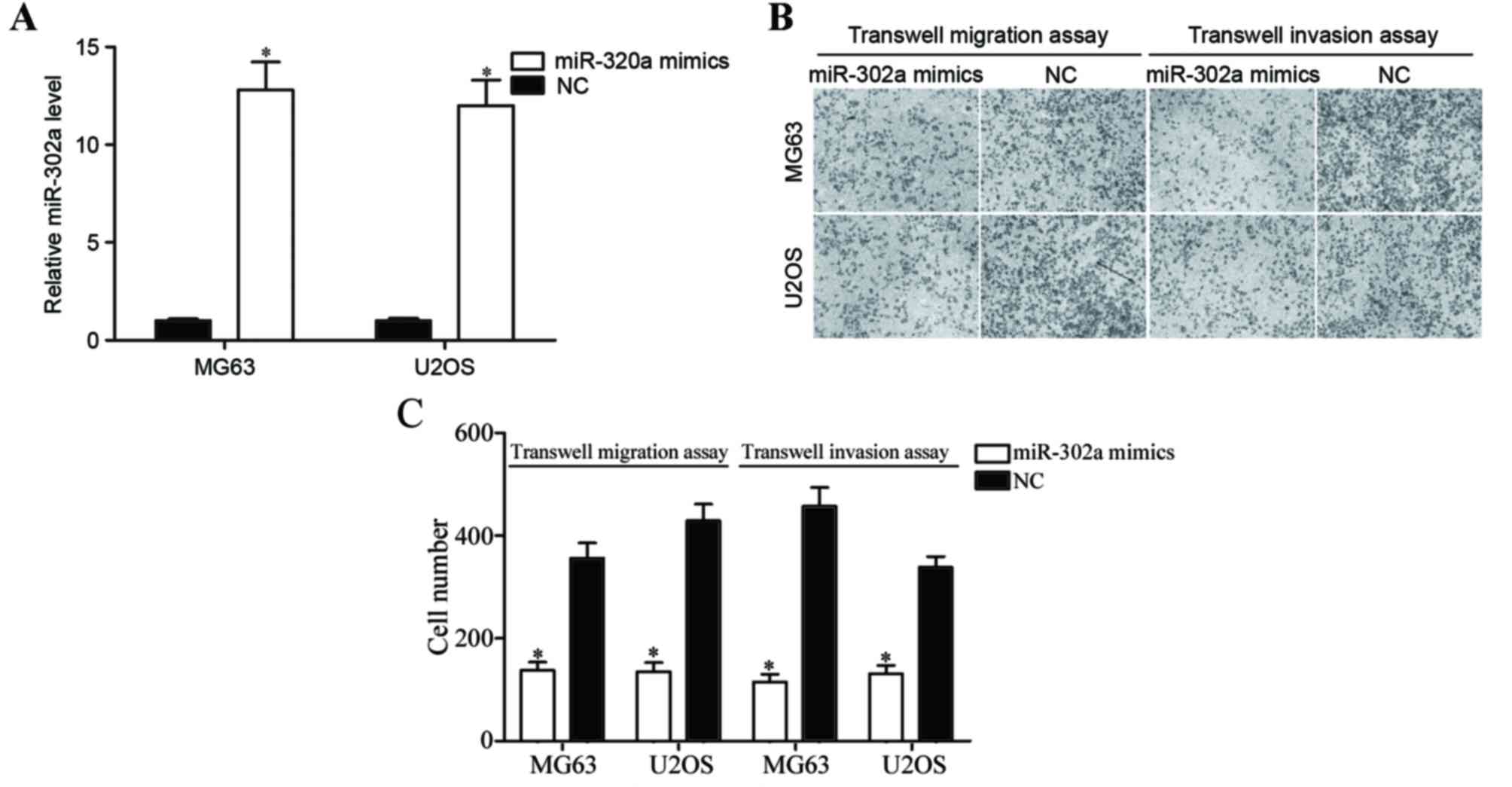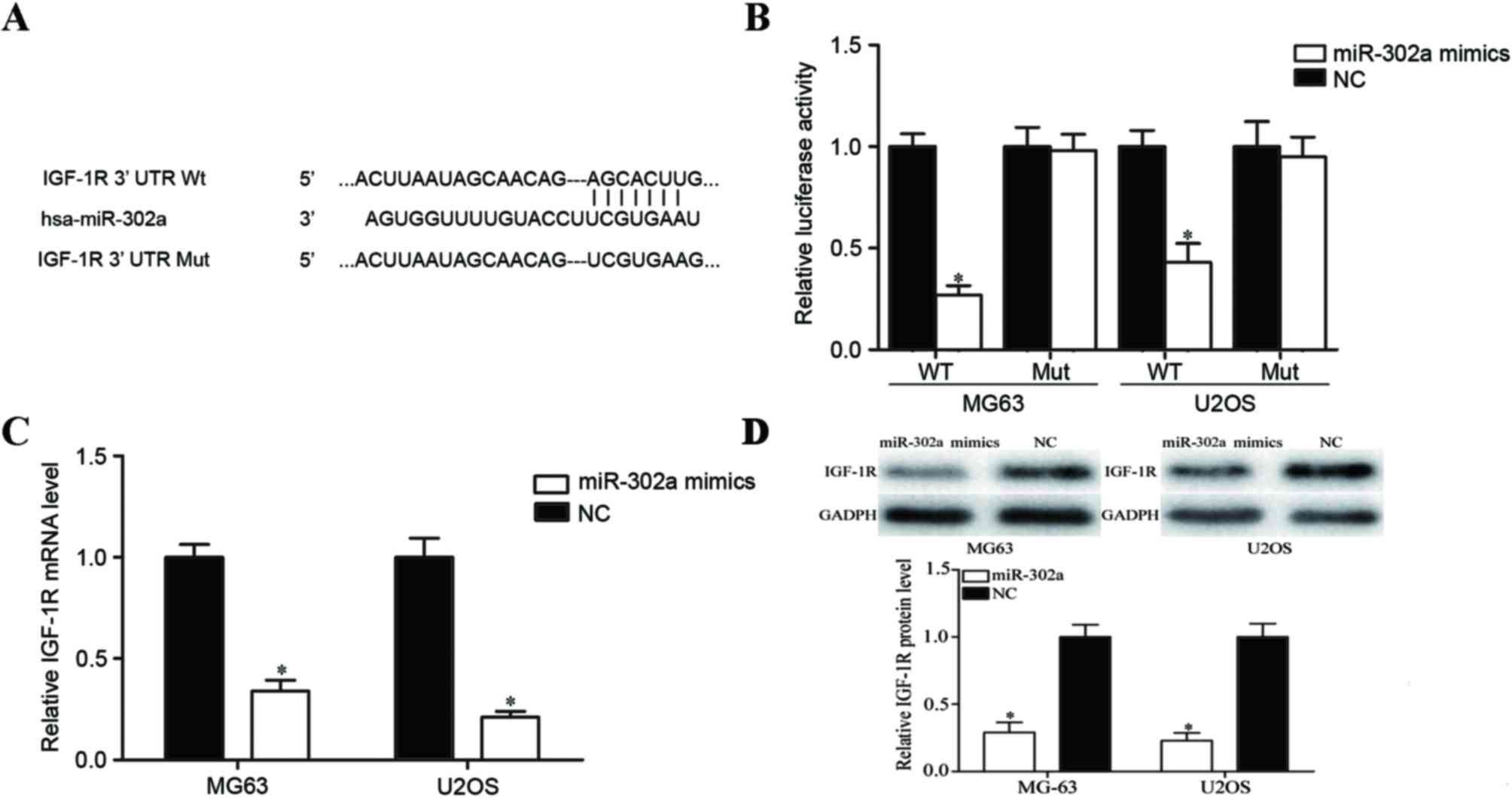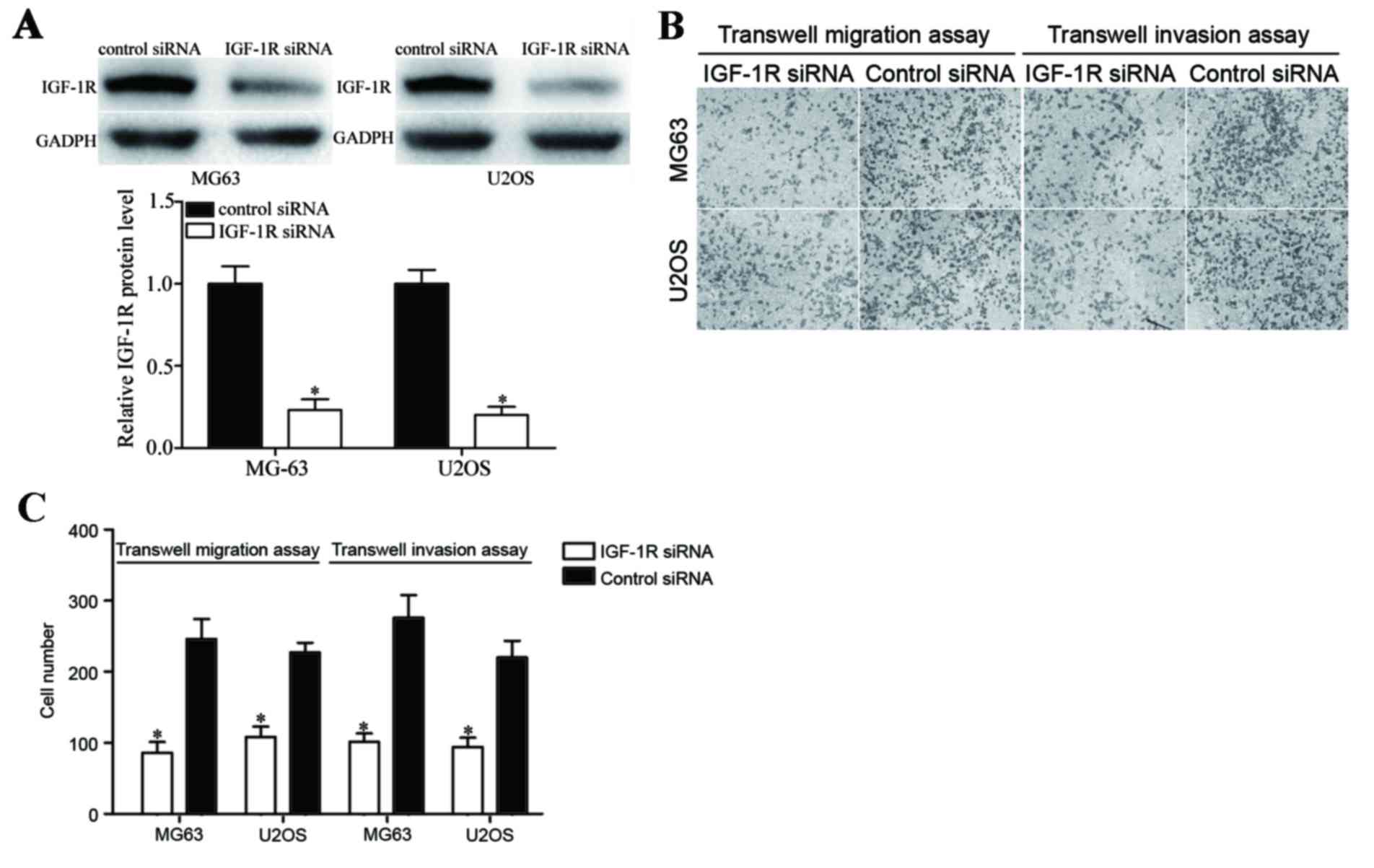MicroRNA-302a inhibits osteosarcoma cell migration and invasion by directly targeting IGF-1R
Retraction in: /10.3892/ol.2022.13480
- Authors:
- Published online on: February 14, 2018 https://doi.org/10.3892/ol.2018.8049
- Pages: 5577-5583
-
Copyright: © Zhang et al. This is an open access article distributed under the terms of Creative Commons Attribution License.
Abstract
Introduction
Osteosarcoma (OS), one of the most frequent types of primary malignant bone neoplasm, originates from the metaphysis of the long bones in children and adolescents (1). The estimated morbidity rate for OS is 4.4 per million worldwide, with a peak incidence at 15–19 years old (2). Phenotypically, OS is relatively homogeneous, but multiple genetic alterations and environmental factors have been demonstrated to be closely associated with carcinogenesis, and progression of OS (3,4). Presently, the main therapeutic strategies for patients with OS are orthopedic surgical intervention, chemotherapy and occasionally radiotherapy (5). Although progress in treatments has occurred, the 5-year overall survival rates for OS patients without metastatic disease are ~50-60%, and is significantly low for those with metastasis (6,7). The majority of patients with OS eventually develop metastasis, particularly pulmonary metastasis, which is the major cause of treatment failures (8). Therefore, it is necessary to understand the molecular mechanism underlying metastasis of OS, and investigate novel therapeutics treatments that target the molecular pathway regulating the metastasis of OS.
MicroRNA (miRNA/miR) are a family of endogenous, non-coding, single stranded and short RNAs of 18–25 nucleotides in length. They modulate gene expression through interactions with complementary sequences in the 3′untranslated regions (3′UTRs) of target mRNAs in a sequence-specific manner, resulting in degradation or translational repression of target mRNAs (9–12). Growing evidence has demonstrated that miRNAs serve important functions in a wide range of physiological and pathological processes, including cell growth, development, differentiation, apoptosis, survival, migration and invasion (13,14). Notably, accumulated evidence has indicated that the aberrant expression of miRNAs is required to maintaining the malignant phenotype of cancer cells, and that they function as tumor suppressors or oncogenes as a result of the diversity of their target mRNAs (15). Particularly, numerous miRNAs have been reported to serve essential functions in carcinogenesis and progression of OS, and may be independent prognostic markers or therapeutic targets for patients with OS (16–18). Therefore, it is essential to further investigate the expression and roles of miRNAs in OS, and provide insight into identifying the novel therapeutic treatment for patients with OS.
Previous studies demonstrated that miR-302a expression is aberrantly expressed in multiple tumor types (19–21). However, miR-302a expression pattern and its biological roles remains to be investigated in OS. The present study aimed to investigate the expression level of miR-302a in OS tissues and cell lines, and the biological roles of miR-302a in OS cells. Furthermore, the molecular mechanism underlying its tumor suppressive roles was evaluated.
Material and methods
Ethics statement and OS tissue samples
The present study was approved by the Ethics Committee of Tianjin Hospital (Tianjin, China) and written informed consent was obtained from all patients involved in the present study. A total of 34 paired OS tissues and matched normal adjacent tissues (NATs) were obtained from patients with OS (20 male and 14 female; age range, 17–63 years; mean age, 38 years) between June 2013 and March 2015. Patients with OS who received other therapeutic treatments prior to surgery were excluded from this study. Upon resection, the OS tissues and matched NATs were immediately snap-frozen in liquid nitrogen and stored at −80°C.
Cell lines and cell culture
The OS HOS, MG63, SAOS2 and U2OS cell lines and human normal osteoblastic hFOB 1.19 cell line were obtained from the American Type Culture Collection (Manassas, VA, USA). All cells were cultured in Dulbecco's modified Eagle's medium supplemented with 10% fetal bovine serum (FBS), 100 U/ml penicillin and 100 U/ml streptomycin (all Gibco; Thermo Fisher Scientific, Inc., Waltham, MA, USA) in a humidified incubator with 5% CO2 at 37°C.
Oligonucleotide transfection
miR-302a mimics and negative control (NC) were purchased from Shanghai GenePharma Co., Ltd. (Shanghai, China). IGF-1R and control siRNAs were synthesized and purified by Guangzhou RiboBio Co., Ltd. (Guangzhou, China). The sequence of the miR-302a mimic was 5′UAAGUGCUUCCAUGUUUUGGUGA3′. The sequence of the NC mimic was 5′UUCUCCGAACGUGUCACGUTT3′. The sequence of the IGF-1R siRNA was 5′CACCGCGGCTGGAAACTCTTCTACACGAATGTAGAAGAGTTTCCAGCCGC3′. The sequence of the control siRNA was 5′CACCGCTCACCGGCTCCAGATTTATCGAAATAAATCTGGAGCCGGTGAGC3′. Oligonucleotide transfection was conducted using Lipofectamine 2000 (Invitrogen; Thermo Fisher Scientific, Inc.) according to the manufacturer's protocol.
Reverse transcription-quantitative polymerase chain reaction (RT-qPCR)
Total RNA was extracted using TRIzol reagent (Invitrogen; Thermo Fisher Scientific, Inc.), and then reverse transcribed into cDNA using the PrimeScript RT-PCR kit (Takara Bio, Inc., Otsu, Japan). The expression levels of miR-302a were determined using SYBR Premix Ex Taq TM II kit (Takara Bio, Inc.), following the manufacturer's protocol. RNU48 was used as the internal control for quantification of miR-302a expression. A total of 200 ng cDNA was used in the qPCR reactions using an ABI7500 Real-time PCR system (Applied Biosystems; Thermo Fisher Scientific, Inc.), and the thermocycler conditions of qPCR were: 5 min at 95°C, followed by 40 cycles of 95°C for 30 sec and 65°C for 45 sec. The expression levels of IGF-1R mRNA were measured using SYBR Green PCR Master Mix (Applied Biosystems; Thermo Fisher Scientific, Inc.), and GAPDH was used to normalize the data for quantification of IGF-1R mRNA expression. The thermocycler conditions of qPCR were as follows: 95°C for 10 min; 40 cycles of 95°C for 15 sec; and 60°C for 1 min. The primer sequences used for qPCR were: miR-302a: forward, 5′CGTGGATGTACTTGCTTTGAA3′; reverse, 5′TCACCAAAACATGGAAGC AC3′; RNU48 forward, 5′CTCGCTTCGGCAGCACATATACT3′; reverse, 5′ACGCTTCACGAATTTGCGTGTC3′; IGF-1R forward, 5′AGGATATTGGGCTTTACAACCTG3′; reverse, 5′GAGGTAACAGAGGTCAGCATTTT3′; GAPDH forward, 5′TGCACCACCAACTGCTTA3′; reverse, 5′GGATGCAGGGATGATGTTC3′. Each sample was examined in triplicate. Data was analyzed using the 2−ΔΔCq method (22).
Transwell migration and Matrigel invasion assay
Transwell migration and Matrigel invasion assays were performed to investigate the effects of miR-302a on the migration and invasion capacity of OS cells. For Matrigel invasion assays, the Transwell chambers (8 mm pore filter) were coated with 100 µl Matrigel (5 mg/ml) (both BD Biosciences, San Jose, CA, USA). For Transwell migration and invasion assays, transfected MG63 and U2OS cells were collected and resuspended in serum-free culture medium. A total of 1×105 transfected cells in 300 µl serum-free culture medium were seeded into the upper chamber, while 500 µl culture medium supplemented with 20% FBS was added to the lower chamber. Following 12 (for migration) or 24 h (for invasion) of incubation at 37°C, the nonmigrated and noninvaded cells were carefully scraped off using a cotton swab. Migrated and invaded cells were fixed, stained with 0.5% crystal violet and washed with PBS, followed by counting using a CKX41 inverted microscope (Olympus Corporation, Tokyo, Japan) at magnification, ×200 in five randomized fields.
Target prediction of miRNAs
miRanda (http://www.microrna.org) and TargetScan version 7.0 (http://www.targetscan.org/) were used to predict the target genes of miR-302a.
Dual-Luciferase report assay
The pGL3-IGF-1R-3′UTR wild-type (Wt) and pGL3-IGF-1R-3′UTR mutant (Mut) were purchased from Shanghai GenePharma Co., Ltd. For the Luciferase report assay, OS cells were transfected with miR-302a mimics or NC, and luciferase reporter vector using Lipofectamine 2000. At 48 h following transfection, cells were collected and luciferase activities were measured using Dual-Luciferase Reporter Assay system (Promega Corporation, Madison, WI, USA), according to the manufacturer's protocol. The Renilla luciferase activities were detected as an internal control for relative firefly luciferase activities.
Western blot analysis
MG63 and U2OS cells were lysed in ice-cold lysis buffer (50 mM Tris-HCl, pH 6.8, 32 mM 2-ME, 2% w/v SDS, 10% glycerol) along with protease inhibitor. Protein concentration was determined and 20 µg protein was separated by 10% SDS-PAGE and transferred to polyvinylidene difluoride membranes (EMD Millipore, Billerica, MA, USA). Subsequent to blocking at 37°C with 5% non-fat milk in Tris-buffered saline (TBS) for 30 min, the membranes were incubated with primary antibodies directed against IGF-1R (1:1,000 dilution; cat. no., ab39398) and GADPH (1:1,000 dilution; cat. no., ab8245; both Abcam, Cambridge, UK) overnight at 4°C. Subsequently, the membranes were washed with TBS-Tween 20, and incubated with the corresponding horseradish peroxidase-conjugated secondary antibodies (1:1,000 dilution; cat. no., ab6785 and ab150077; Abcam) for 1 h at room temperature. An enhanced chemiluminescent system (EMD Millipore) was used to visualize signal bands, and analyzed with Image Lab software (version 3.0; Bio-Rad Laboratories, Inc., Hercules, CA, USA).
Statistical analysis
Data are presented as the mean ± standard deviation. The differences between groups were compared with Student's t test or one-way analysis of variance using SPSS statistical software (version 13.0; SPSS Inc., Chicago, IL, USA). P<0.05 was considered to indicate a statistically significant difference.
Results
miR-302a mRNA expression is downregulated in OS tissues and cell lines
miR-302a has been studied in numerous human cancer types; however, its expression and functions in OS have not been investigated previously. In the present study, the expression levels of miR-302a were measured in OS tissue samples. It was revealed that the expression of miR-302a were significantly lower in OS tissue compared with that in matched NATs (Fig. 1A; P<0.05). In addition, the expression of miR-302a in OS tissue with metastasis was significantly lower compared with that in OS tissue without metastatic disease (Fig. 1B; P<0.05). miR-302a expression was determined in OS cell lines and the human normal osteoblastic hFOB 1.19 cell line. As demonstrated in Fig. 1C, miR-302a was significantly downregulated in OS cell lines compared with that in hFOB 1.19 cells (P<0.05). These results indicate that miR-302a is downregulated in OS and may be involved in the metastasis of OS.
miR-302a inhibits the migration and invasion of OS cells in vitro
To investigate the effects of miR-302a in the metastasis of OS, OS cells were transfected with miR-302a mimics or NC, and then subjected to Transwell migration and Matrigel invasion assays. In the four OS cell lines, MG63 and U2OS cell lines were selected for functional experiments due to lower miR-302a expression levels. Following transfection, miR-302a expression relative to GAPDH was assessed using RT-qPCR. As demonstrated in Fig. 2A, miR-302a expression was significantly upregulated in MG63 and U2OS cells transfected with miR-302a mimics compared with those transfected with the negative control (P<0.05). Transwell migration and invasion assays revealed that the overexpression of miR-302a inhibited migration and invasion capacity of MG63 and U2OS cells (Fig. 2B and C; both P<0.05). These results indicate that miR-302a acts as a tumor metastasis suppressor in OS.
IGF-1R is a direct target gene of miR-302a in OS
To determine the molecular mechanism underlying miR-302a in the metastasis of OS, miRanda and TargetScan databases were used to predict potential target genes of miR-302a. IGF-1R was predicted to be one of its targets (Fig. 3A). To confirm this predication, a Dual-Luciferase reporter assay was performed. The results demonstrated that the overexpression of miR-302a decreased the luciferase activities of pGL3-IGF-1R-3′UTR Wt; however, no significant differences in the luciferase activities of pGL3-IGF-1R-3′UTR Mut were observed when compared to the negative control groups (Fig. 3B; P<0.05). Furthermore, RT-qPCR and western blot analyses were performed to investigate the regulatory effects of miR-302a on IGF-1R mRNA and protein expression. As illustrated in Fig. 3C and D, IGF-1R was significantly downregulated at mRNA and protein levels in miR-302a mimics-transfected MG63 and U2OS cells (all P<0.05). These results suggest that IGF-1R is a direct target gene of miR-302a in OS.
Knockdown IGF-1R mimics functions with miR-302a overexpression of OS cells
To investigate the effects of IGF-1R in OS cells, MG63 and U2OS cells were transfected with IGF-1R siRNA or control siRNA, and then Transwell migration and Matrigel invasion assays were performed. As illustrated in Fig. 4A, IGF-1R siRNA reduced IGF-1R expression at the protein level compared with the control siRNA treated group. In addition, downregulation of IGF-1R in MG63 and U2OS cells significantly inhibited the migration and invasion abilities of cells compared with the control group (Fig. 4B and C; P<0.05). These findings indicate that IGF-1R silencing and miR-302a overexpression possess similar functions resulting in cell migration and invasion suppression.
Discussion
Metastasis serves an important role in OS progression, and the majority of mortalities of patients with OS are primarily due to complications arising from metastasis. The molecular mechanisms underlying the carcinogenesis and progression of OS are apparent, however the molecular basis of the presence of metastasis remains unclear. Therefore, studies investigating the molecular mechanism underlying the metastasis of OS are warranted, in order to develop more efficient therapeutic strategies to treat patients with OS and prevent metastasis. Increasing evidences have indicated that miRNAs perform essential regulatory functions in numerous biological events, including metastasis (13,14). In the current study, the expression levels of miR-302a were determined in OS tissue and cell lines using RT-qPCR. The results demonstrated that miR-302a was significantly downregulated in OS tissues and cell lines. In addition, the downregulation of miR-302a in OS tissues was significantly associated with metastasis. Furthermore, enforced miR-302a expression inhibited metastasis of OS cells, suggesting its involvement in OS metastasis. To the best of our knowledge, this is the first study to investigate the expression and function of miR-302a in OS.
miR-302a has been primarily studied in ovarian (19), colorectal (20), prostate (21) and breast (23) cancer. Guo et al (19) reported that miR-302a was downregulated in ovarian cancer, and upregulation of miR-302a significantly inhibited cancer cell proliferation and improved apoptosis through targeting SDC1. In addition, expression of miR-302a was lower in colorectal cancer cells compared with that in normal colon epithelium cells. Overexpression of miR-302a suppressed growth and invasion capacity of colorectal cancer cells via regulation of mitogen-activated protein kinase, and phosphoinositide 3-kinase/protein kinase B (Akt) signaling pathways (20). In prostate cancer, miR-302a expression levels were demonstrated to be decreased in cancer tissue samples, particularly in tissues with a Gleason score of ≥8. Enforced miR-302a expression in prostate cancer cells resulted in a significant suppression in cell growth in vitro and in vivo, and enhanced G1/S cell cycle arrest by targeting Akt (21). Liang et al (23) revealed that miR-302a was downregulated in metastatic breast cancer cells and tumor tissue samples. Ectopic expression of miR-302a suppressed invasion and metastasis of breast cancer cell in vitro, and in vivo via blockade of C-X-C chemokine receptor 4 (23). Furthermore, miR-302a was demonstrated to contribute to radioresistance of breast cancer cells. Lower miR-302a expression was revealed in irradiated breast cancer cells, and sensitized radioresistant breast cancer cells to radiation therapy in vitro and in vivo through negative regulation of AKT1 and RAD52 homolog DNA repair protein (24). These findings indicate that miR-302a serves important functions in the tumorigenesis and progression of these cancer types, and is a promising molecular target for the treatment of such diseases.
In the present study, IGF-1R was demonstrated to be a direct target gene of miR-302a in OS. To validate the molecular mechanism underlying the suppressive functions of miR-302a in the metastasis of OS, miRanda and TargetScan was used to predict the potential target genes of miR-302a. The analysis revealed that IGF-1R was one of the targets of miR-302a. To confirm this prediction, luciferase reporter assays were performed. The results indicated that the overexpression of miR-302a decreased the luciferase activities of IGF-1R-3′UTR Wt; however, no significant differences in the luciferase activities of IGF-1R-3′UTR Mut were observed. Furthermore, RT-qPCR and western blot analysis demonstrated that IGF-1R was downregulated in OS cells at mRNA and protein levels following transfection with miR-302a. The results of the current study also indicate that miR-302a expression levels are associated with metastatic features of OS. Taken together, it is reasonable to suggest that alterations in miR-302a expression modulate the metastasis of OS cells via directly targeting IGF-1R.
IGF-1R, a transmembrane tyrosine kinase receptor of the insulin receptor family, has been reported to serve essential functions in carcinogenesis and tumor progression, including malignant transformation, proliferation, anti-apoptosis, vascularization, and metastasis (25,26). It has been demonstrated to be upregulated in various human cancer types, such as hepatocellular carcinoma, non-small lung cancer and prostate cancer (27–29). Furthermore, in OS, IGF-1R was revealed to be upregulated in OS tissues, and expression levels of IGF-1R were correlated with poor prognosis of patients with OS. In functional studies, the knockdown of IGF-1R resulted in a decrease in the adhesion, motility and metastasis of OS (28). In the present study, it was revealed that the downregulation of IGF-1R inhibited the migration and invasion capacity of OS cells. Therefore, regarding its cancer-associated functions, it is warranted that IGF-1R is investigated as a potential target for the treatment of patients with OS.
In conclusion, the results of the present study demonstrated that miR-302a is downregulated in OS, and acts as a tumor metastasis suppressor in human OS through targeting IGF-1R. The capacity of miR-302a to suppress metastasis of OS may provide a novel approach to preventing metastasis in patients with OS.
References
|
Geller DS and Gorlick R: Osteosarcoma: A review of diagnosis, management, and treatment strategies. Clin Adv Hematol Oncol. 8:705–718. 2010.PubMed/NCBI | |
|
Liu J, Xue H, Zhang J, Suo T, Xiang Y, Zhang W, Ma J, Cai D and Gu X: MicroRNA-144 inhibits the metastasis of gastric cancer by targeting MET expression. J Exp Clin Cancer Res. 34:352015. View Article : Google Scholar : PubMed/NCBI | |
|
Kansara M and Thomas DM: Molecular pathogenesis of osteosarcoma. DNA Cell Biol. 26:1–18. 2007. View Article : Google Scholar : PubMed/NCBI | |
|
Gorlick R: Current concepts on the molecular biology of osteosarcoma. Cancer Treat Res. 152:467–478. 2009. View Article : Google Scholar : PubMed/NCBI | |
|
Wang L, Jin F, Qin A, Hao Y, Dong Y, Ge S and Dai K: Targeting Notch1 signaling pathway positively affects the sensitivity of osteosarcoma to cisplatin by regulating the expression and/or activity of Caspase family. Mol Cancer. 13:1392014. View Article : Google Scholar : PubMed/NCBI | |
|
Osaki M, Takeshita F, Sugimoto Y, Kosaka N, Yamamoto Y, Yoshioka Y, Kobayashi E, Yamada T, Kawai A, Inoue T, et al: MicroRNA-143 regulates human osteosarcoma metastasis by regulating matrix metalloprotease-13 expression. Mol Ther. 19:1123–1130. 2011. View Article : Google Scholar : PubMed/NCBI | |
|
Bramer JA, van Linge JH, Grimer RJ and Scholten RJ: Prognostic factors in localized extremity osteosarcoma: A systematic review. Eur J Surg Oncol. 35:1030–1036. 2009. View Article : Google Scholar : PubMed/NCBI | |
|
Marina N, Gebhardt M, Teot L and Gorlick R: Biology and therapeutic advances for pediatric osteosarcoma. Oncologist. 9:422–441. 2004. View Article : Google Scholar : PubMed/NCBI | |
|
Nikiforova MN, Gandhi M, Kelly L and Nikiforov YE: MicroRNA dysregulation in human thyroid cells following exposure to ionizing radiation. Thyroid. 21:261–266. 2011. View Article : Google Scholar : PubMed/NCBI | |
|
He L and Hannon GJ: MicroRNAs: Small RNAs with a big role in gene regulation. Nat Rev Genet. 5:522–531. 2004. View Article : Google Scholar : PubMed/NCBI | |
|
Valencia-Sanchez MA, Liu J, Hannon GJ and Parker R: Control of translation and mRNA degradation by miRNAs and siRNAs. Genes Dev. 20:515–524. 2006. View Article : Google Scholar : PubMed/NCBI | |
|
Winter J, Jung S, Keller S, Gregory RI and Diederichs S: Many roads to maturity: MicroRNA biogenesis pathways and their regulation. Nat Cell Biol. 11:228–234. 2009. View Article : Google Scholar : PubMed/NCBI | |
|
Yates LA, Norbury CJ and Gilbert RJ: The long and short of microRNA. Cell. 153:516–519. 2013. View Article : Google Scholar : PubMed/NCBI | |
|
Tahara H, Kay MA, Yasui W and Tahara E: MicroRNAs in cancer: The 22nd hiroshima cancer seminar/the 4th Japanese association for RNA interference joint international symposium, 30 August 2012, grand prince hotel hiroshima. Jpn J Clin Oncol. 43:579–582. 2013. View Article : Google Scholar : PubMed/NCBI | |
|
Cai Y, Yu X, Hu S and Yu J: A brief review on the mechanisms of miRNA regulation. Genomics Proteomics Bioinformatics. 7:147–154. 2009. View Article : Google Scholar : PubMed/NCBI | |
|
Namløs HM, Meza-Zepeda LA, Barøy T, Østensen IH, Kresse SH, Kuijjer ML, Serra M, Bürger H, Cleton-Jansen AM and Myklebost O: Modulation of the osteosarcoma expression phenotype by microRNAs. PLoS One. 7:e480862012. View Article : Google Scholar : PubMed/NCBI | |
|
Tian K, Di R and Wang L: MicroRNA-23a enhances migration and invasion through PTEN in osteosarcoma. Cancer Gene Ther. 22:351–359. 2015. View Article : Google Scholar : PubMed/NCBI | |
|
Liu W, Zhao ZY, Shi L and Yuan WD: Tissue microRNA-126 expression level predicts outcome in human osteosarcoma. Diagn Pathol. 10:1162015. View Article : Google Scholar : PubMed/NCBI | |
|
Guo T, Yu W, Lv S, Zhang C and Tian Y: MiR-302a inhibits the tumorigenicity of ovarian cancer cells by suppression of SDC1. Int J Clin Exp Pathol. 8:4869–4880. 2015.PubMed/NCBI | |
|
Wei ZJ, Tao ML, Zhang W, Han GD, Zhu ZC, Miao ZG, Li JY and Qiao ZB: Up-regulation of microRNA-302a inhibited the proliferation and invasion of colorectal cancer cells by regulation of the MAPK and PI3K/Akt signaling pathways. Int J Clin Exp Pathol. 8:4481–4491. 2015.PubMed/NCBI | |
|
Zhang GM, Bao CY, Wan FN, Cao DL, Qin XJ, Zhang HL, Zhu Y, Dai B, Shi GH and Ye DW: MicroRNA-302a suppresses tumor cell proliferation by inhibiting AKT in prostate cancer. PLoS One. 10:e01244102015. View Article : Google Scholar : PubMed/NCBI | |
|
Livak KJ and Schmittgen TD: Analysis of relative gene expression data using real-time quantitative PCR and the 2(-Delta Delta C(T)) method. Methods. 25:402–408. 2001. View Article : Google Scholar : PubMed/NCBI | |
|
Liang Z, Bian X and Shim H: Inhibition of breast cancer metastasis with microRNA-302a by downregulation of CXCR4 expression. Breast Cancer Res Treat. 146:535–542. 2014. View Article : Google Scholar : PubMed/NCBI | |
|
Liang Z, Ahn J, Guo D, Votaw JR and Shim H: MicroRNA-302 replacement therapy sensitizes breast cancer cells to ionizing radiation. Pharm Res. 30:1008–1016. 2013. View Article : Google Scholar : PubMed/NCBI | |
|
Werner H and LeRoith D: The role of the insulin-like growth factor system in human cancer. Adv Cancer Res. 68:183–223. 1996. View Article : Google Scholar : PubMed/NCBI | |
|
Pollak M: The insulin and insulin-like growth factor receptor family in neoplasia: An update. Nat Rev Cancer. 12:159–169. 2012. View Article : Google Scholar : PubMed/NCBI | |
|
Wang YH, Wang ZX, Qiu Y, Xiong J, Chen YX, Miao DS and De W: Lentivirus-mediated RNAi knockdown of insulin-like growth factor-1 receptor inhibits growth, reduces invasion, and enhances radiosensitivity in human osteosarcoma cells. Mol Cell Biochem. 327:257–266. 2009. View Article : Google Scholar : PubMed/NCBI | |
|
Wang YH, Han XD, Qiu Y, Xiong J, Yu Y, Wang B, Zhu ZZ, Qian BP, Chen YX, Wang SF, et al: Increased expression of insulin-like growth factor-1 receptor is correlated with tumor metastasis and prognosis in patients with osteosarcoma. J Surg Oncol. 105:235–243. 2012. View Article : Google Scholar : PubMed/NCBI | |
|
Scharf JG and Braulke T: The role of the IGF axis in hepatocarcinogenesis. Horm Metab Res. 35:685–693. 2003. View Article : Google Scholar : PubMed/NCBI |













